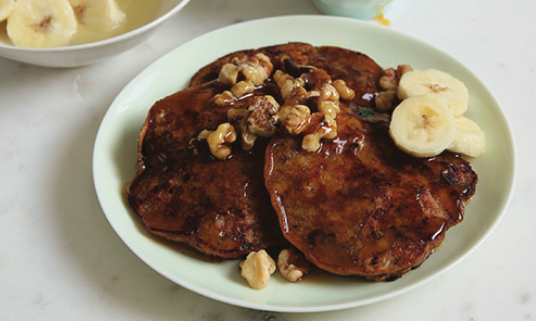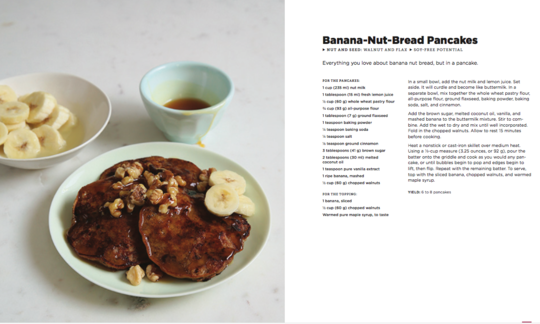Banana-Nut-Bread Pancakes with Flaxseed and Walnuts
vegan
Ingredients (for servings, )
| For the pancakes | |
|---|---|
| 235 ml | Almond milk (raw?, organic?) (7.9 oz) |
| 15 ml | Lemon juice (raw?, organic?) (0.54 oz) |
| 1 tbsp, ground | Linseed, raw, organic? (golden linseed, flax) (0.25 oz) |
| 2 ⅛ oz | Wheat flour, wholemeal (organic?) |
| 3 ⅓ oz | Wheat flour (raw?, organic?) |
| 1 tsp | Baking powder (baking agent, organic?, vegan?) (0.11 oz) |
| ¼ tsp | Baking soda (organic?) (0.04 oz) |
| ¼ tsp | Table salt (table salt, raw?, organic?) (0.05 oz) |
| ½ tsp | Cinnamon (ground, raw, organic?) (0.05 oz) |
| 1 | Bananas, raw (organic?) (4.1 oz) |
| 3 tbsp | Brown sugar (raw sugar, whole cane sugar, whole sugar, organic?) (0.95 oz) |
| 2 tbsp | Coconut oil (coconut oil, coconut fat, organic?, raw?) (0.96 oz) |
| 1 tsp | Vanilla extract, natural (organic?) (0.15 oz) |
| 2 ⅛ oz | Walnuts (tree nuts), raw (organic?) |
| For the topping | |
| 1 | Bananas, raw (organic?) (4.1 oz) |
| 2 ⅛ oz | Walnuts (tree nuts), raw (organic?) |
| 1 tbsp | Maple syrup (organic?, raw?) (0.70 oz) |
Equipment
- whisk
- skillet (frying pan)
- stove
- coffee grinder, electric
- citrus juicer (lemon squeezer)
Type of preparation
- fry
- chop or grind
- blend
- squeeze
- meld
- melt
Preparation
For the pancakes
In a small bowl, add the nut milk and lemon juice. Set aside. It will curdle and become like buttermilk.The original recipe calls for nut milk. We have listed almond milk as it is readily available. For further information on nut milk and making your own, please see the “Tips” section.
Grind the flaxseed (e.g., in an electric coffee grinder). In a separate bowl, mix together the whole wheat flour, flour, ground flaxseed, baking powder, baking soda, salt, and cinnamon.
Mash the ripe banana with a fork. Add the brown sugar, melted coconut oil, vanilla, and mashed banana to the buttermilk mixture. Stir to combine. Add the wet to dry and mix until well incorporated. Chop the walnuts and fold in to the mixture. Allow to rest 15 minutes before cooking.
The authors use ripe bananas for the batter and the topping.
Heat a nonstick or cast-iron skillet over medium heat. Using a 1⁄3-cup measure (3.25 ounces or 92 g), pour the batter onto the griddle and cook as you would any pancake, or until bubbles begin to pop and edges begin to lift, then flip. Repeat with the remaining batter.
The ingredients for 4 servings yield enough for 6–8 pancakes (depending on the thickness).
Serve
Slice the bananas. Chop the walnuts and warm the maple syrup. To serve, top with the sliced banana, chopped walnuts, and warmed maple syrup (to taste).
|
Nutritional Information per person
Convert per 100g
|
2000 kcal | |
|---|---|---|
| Energy | 507 kcal | 25.4% |
| Fat/Lipids | 29 g | 41.3% |
| Saturated Fats | 7.8 g | 38.8% |
| Carbohydrates (inc.dietary fiber) | 57 g | 21.1% |
| Sugars | 18 g | 20.0% |
| Fiber | 6.7 g | 26.9% |
| Protein/Albumin | 11 g | 21.3% |
| Cooking Salt (Na:350.1 mg) | 889 mg | 37.0% |
| Essential micronutrients with the highest proportions | per person | 2000 kcal | |
|---|---|---|---|
| Fat | Alpha-Linolenic acid; ALA; 18:3 omega-3 | 3.2 g | 158.0% |
| Fat | Linoleic acid; LA; 18:2 omega-6 | 12 g | 122.0% |
| Min | Manganese, Mn | 2.2 mg | 112.0% |
| Min | Copper, Cu | 0.66 mg | 66.0% |
| Prot | Tryptophan (Trp, W) | 0.12 g | 49.0% |
| Elem | Phosphorus, P | 332 mg | 47.0% |
| Sodium, Na | 350 mg | 44.0% | |
| Min | Selenium, Se | 21 µg | 38.0% |
| Prot | Threonine (Thr, T) | 0.35 g | 37.0% |
| Vit | Vitamin B6 (pyridoxine) | 0.46 mg | 33.0% |
Detailed Nutritional Information per Person for this Recipe
The majority of the nutritional information comes from the USDA (US Department of Agriculture). This means that the information for natural products is often incomplete or only given within broader categories, whereas in most cases products made from these have more complete information displayed.
If we take flaxseed, for example, the important essential amino acid ALA (omega-3) is only included in an overarching category whereas for flaxseed oil ALA is listed specifically. In time, we will be able to change this, but it will require a lot of work. An “i” appears behind ingredients that have been adjusted and an explanation appears when you hover over this symbol.
For Erb Muesli, the original calculations resulted in 48 % of the daily requirement of ALA — but with the correction, we see that the muesli actually covers >100 % of the necessary recommendation for the omega-3 fatty acid ALA. Our goal is to eventually be able to compare the nutritional value of our recipes with those that are used in conventional western lifestyles.
| Essential fatty acids | per person | 2000 kcal |
|---|---|---|
| Alpha-Linolenic acid; ALA; 18:3 omega-3 | 3.2 g | 158.0% |
| Linoleic acid; LA; 18:2 omega-6 | 12 g | 122.0% |
| Essential amino acids | per person | 2000 kcal |
|---|---|---|
| Tryptophan (Trp, W) | 0.12 g | 49.0% |
| Threonine (Thr, T) | 0.35 g | 37.0% |
| Isoleucine (Ile, I) | 0.40 g | 33.0% |
| Phenylalanine (Phe, F) | 0.52 g | 33.0% |
| Leucine (Leu, L) | 0.77 g | 32.0% |
| Valine (Val, V) | 0.49 g | 30.0% |
| Methionine (Met, M) | 0.17 g | 18.0% |
| Lysine (Lys, K) | 0.29 g | 16.0% |
| Vitamins | per person | 2000 kcal |
|---|---|---|
| Vitamin B6 (pyridoxine) | 0.46 mg | 33.0% |
| Biotin (ex vitamin B7, H) | 16 µg | 31.0% |
| Folate, as the active form of folic acid (née vitamin B9 and | 58 µg | 29.0% |
| Thiamine (vitamin B1) | 0.25 mg | 23.0% |
| Riboflavin (vitamin B2) | 0.28 mg | 20.0% |
| Vitamin E, as a-TEs | 1.5 mg | 13.0% |
| Niacin (née vitamin B3) | 1.8 mg | 12.0% |
| Pantothenic acid (vitamin B5) | 0.60 mg | 10.0% |
| Vitamin C (ascorbic acid) | 7.0 mg | 9.0% |
| Vitamin A, as RAE | 19 µg | 2.0% |
| Vitamin K | 1.7 µg | 2.0% |
| Essential macroelements (macronutrients) | per person | 2000 kcal |
|---|---|---|
| Phosphorus, P | 332 mg | 47.0% |
| Sodium, Na | 350 mg | 44.0% |
| Magnesium, Mg | 103 mg | 27.0% |
| Potassium, K | 480 mg | 24.0% |
| Calcium, Ca | 147 mg | 18.0% |
| Essential trace elements (micronutrients) | per person | 2000 kcal |
|---|---|---|
| Manganese, Mn | 2.2 mg | 112.0% |
| Copper, Cu | 0.66 mg | 66.0% |
| Selenium, Se | 21 µg | 38.0% |
| Zinc, Zn | 1.8 mg | 18.0% |
| Iron, Fe | 2.0 mg | 14.0% |
| Iod, I (Jod, J) | 4.5 µg | 3.0% |
| Fluorine, F | 1.3 µg | < 0.1% |
Banana-Nut-Bread Pancakes with Flaxseed and Walnuts are everything you love about banana nut bread, but in a pancake.
Servings: The ingredients for 4 servings yield enough for 6–8 pancakes (depending on the thickness).
Nutritional profile: According to GDA guidelines, one serving of this recipe covers more than the recommended daily requirement for omega-6 and omega-3 fatty acids. At 5:1, the ratio between linoleic acid (LA) and alpha-linolenic acid (ALA) is under the recommended maximum ratio of 5:1. It also covers almost 40 % of the daily requirement for selenium and 100 % for manganese.
Nut milk: This is a plant-based milk that is made from nuts and water (see “Tips”).
Flaxseed: Flaxseed are the seeds of the flax plant (common flax or linseed: Linum usitatissimum). They have a slightly nutty flavor and contain 40 % fat. Since this consists of about 50 % polyunsaturated omega-3 fatty acids (ALA), flaxseed oil has the highest concentration of omega-3 fatty acids of all known vegetable oils. People who eat a lot of convenience foods should increase the amount of flaxseed in their diet in order to in this respect somewhat compensate for poor dietary choices.
Walnuts: Walnuts are the nuts that contain the highest proportion of linolenic acid (ALA). In addition, they are rich in vitamin E, zinc (an important trace element for the liver and hair), and potassium (essential for the functioning of the heart and other organs).
Coconut oil: Coconut oil is solid at room temperature, but has a very low melting point and therefore turns very quickly to liquid. Given its high content of saturated fatty acids, coconut oil can more safely be heated to high temperatures (higher smoke point) and is as such suitable for frying, baking, deep-frying, and general cooking. But at 82 % saturated fatty acids, we do not recommend coconut oil, even if it is highly praised by the food industry. Read more about this in the article: A Vegan Diet Can Be Unhealthy. Nutrition Mistakes.
Baking powder vs. baking soda: Like baking powder, baking soda (also called sodium bicarbonate) is used to make baked goods rise better. However, it has a much stronger effect than baking powder and requires the presence of an acid to be effective. Baking powder is a mixture of sodium carbonate and a weak acid. Weinstein baking powder contains cream of tartar, which is a natural by-product in the wine-making process that is obtained from the crystalline deposits found inside wine barrels. It also contains cornstarch instead of flour (used as a separating agent).
Nut milk: We have listed almond milk as it is readily available. It is generally preferable to use unprocessed products. And it’s also easy to make your own almond milk. Here’s a recipe that you can use: Raw Almond Milk. Walnut milk is an even healthier type of plant-based milk. Walnuts have a good ratio of omega-6 to omega-3 fatty acids whereas almonds contain almost no omega-3 fatty acids.
Whole wheat flour: We recommend that you use 100 % whole wheat flour. Whole wheat flour is grain that has only had the awns and husks removed after harvesting. Fiber, vitamins, oils, and minerals are therefore retained in the bran and the germ. The oils have a particularly high nutritional value as they contain large amounts of essential fatty acids.
Healthy oils: Coconut oil contains mainly saturated fatty acids. The triglyceride content with unsaturated fatty acids is therefore extremely low. In terms of nutritional physiology, however, it is specifically the unsaturated, essential omega-6 (LA) and omega-3 fatty acids (ALA) that are important.
Canola oil contains high levels of essential fatty acids (esp. alpha-linolenic acid). With an LA:ALA ratio of 2:1, canola oil is an excellent choice and can help considerably to obtain an overall maximum ratio of 5:1. We recommend using healthy oils whenever possible.
Reducing the sugar: If you don’t need it to be so sweet, you can reduce the amount of sugar you add or even leave out the sugar. The banana alone may make the bread sweet enough.
Replace baking soda with baking powder: If you want to replace the baking soda, you can instead use two to three times the amount of baking powder.





